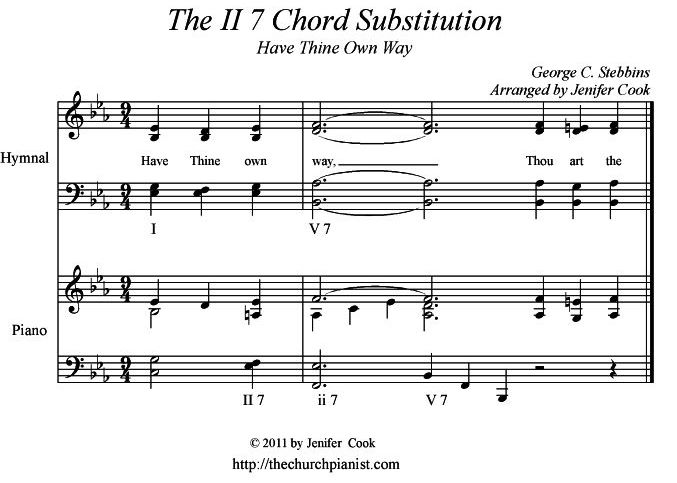Lesson Two: The II 7 Chord Substitution with Have Thine Own Way
Chord Scenario for this II 7 Chord Substitution:
When a I chord lasts for at least two beats and leads into a V or V 7 chord that lasts 3 or more beats…the II 7 can replace a I chord.
On to our example in Have Thine Own Way in E flat major. Since E flat is the first note in the key of E flat…it is number one. So F is the second note in the key of E flat major. The ii chord would be: F-A flat-C.
Now let’s alter this minor ii chord by making it major. Raise the middle note to A natural. Are you beginning to catch on? You now have the II chord: F-A natural-C See illustration below:
 *I added an E flat (not shown)… on the top of the II chord…making it a II 7 (the E flat is 7 notes from the bottom note (F). Added 7ths make a chord sound SO much richer!
*I added an E flat (not shown)… on the top of the II chord…making it a II 7 (the E flat is 7 notes from the bottom note (F). Added 7ths make a chord sound SO much richer!
*You’ll notice the note members of the II 7 chord in the following excerpt are scrambled between both hands. The note “C” is missing (which is ok)… but the rest are present.
 ~ ~ ~ ~ ~ ~ ~ ~ ~ ~ ~ ~ ~ ~ ~ ~ ~ ~ ~
~ ~ ~ ~ ~ ~ ~ ~ ~ ~ ~ ~ ~ ~ ~ ~ ~ ~ ~
Now…a couple more examples of the II 7 chord substitution in the key of A flat & G Major.
~ ~ ~ ~ ~ ~ ~ ~ ~ ~ ~ ~ ~ ~ ~ ~ ~ ~ ~
Are you wondering how to use the ii 7 chord in each example? Whenever a V or V7 chord is lasting three or more beats…use the ii 7 chord first and then resolve to the written V or V 7 chord. I’ll share examples of this chord substitution in another article. So much to share!
Church Pianist Tip: Remember…chord substitutions can not be used during congregational singing unless they are singing unison. Why? Because the substitution chords will conflict with the voice parts.


Loving this! Going to go apply it right now. 😉